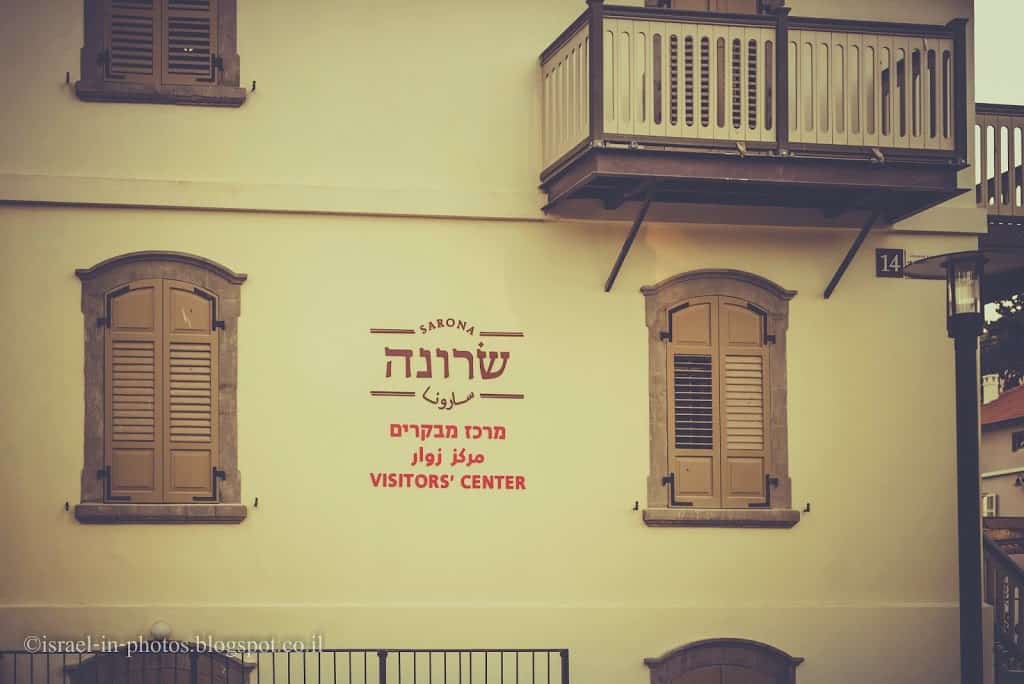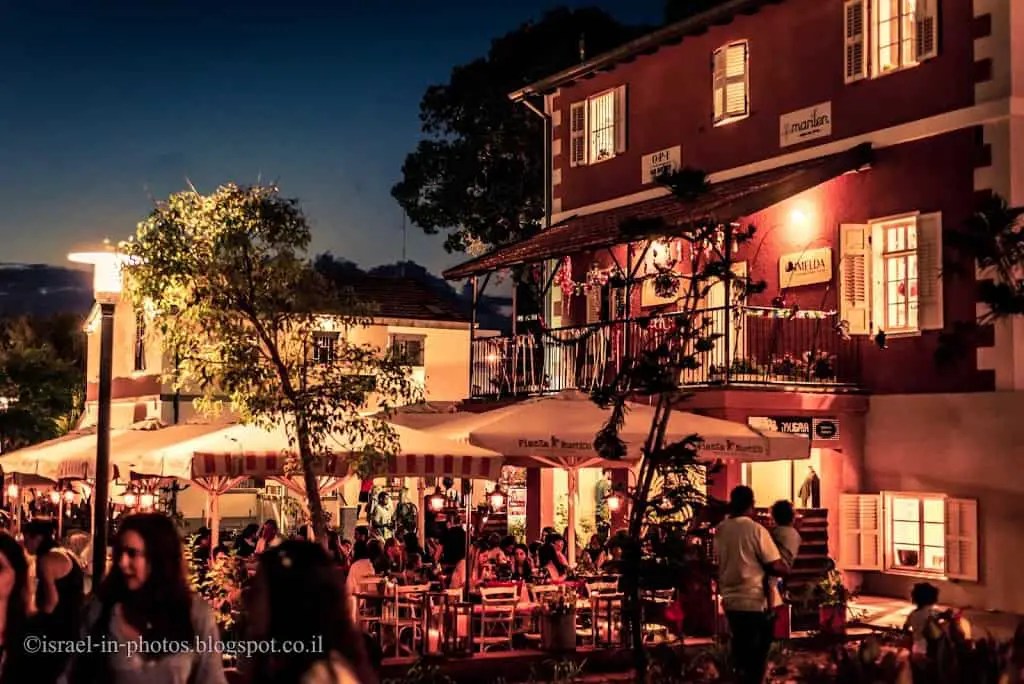Sarona Neighborhood, Tel Aviv – Visitors Guide
Sarona, which began as a German Templer Colony in 1871, was recently restored and converted into a shopping and entertainment area.
Table of Contents
Map
Sarona is located at Rav Aluf David Elazar Street 6, Tel Aviv. That is about a five to ten-minute walk from the Azrieli Center.
Directions for drivers: Link to Waze and Link to Google Maps
Directions for public transport: Link to Moovit
Interactive map of the area:
And here is a map of Sarona. It consists of many small buildings which mainly house stores and restaurants. And on the ground floor, beneath the three skyscrapers, you can find Sarona Market.
Note: you can click on the map to enlarge it.
Directions
If you are using public transport, then a variety of buses reach this area. Here is already a preset link to Moovit. Just enter your starting point, and you will get the updated directions.
And if you are driving, then you will need to find parking.
Parking
There are several paid parking lots in the area. I usually prefer to park at the Azrieli Center due to the easy access from the Ayalon highway. And walk the rest of the way.
Also, see the parking offer that I mentioned at Sarona Market.
History
Sarona was a German Templer colony, and now it is a Tel Aviv neighborhood.
The history of this neighborhood started in 1871 when the Templars purchased 60 hectares of land from a Greek monastery north of Jaffa. And in the same year, foundation stones were laid for the first houses.

And here is a historical extract from Wikipedia:
In August 1871, the Templers purchased 60 hectares of land from a Greek monastery north of Jaffa. Part of the Plains of Sharon (after which it was named), near the River Auja (Yarkon), it was four kilometers from Jaffa.
By 1889, 269 people lived in Sarona. There were 41 homes, a communal hall, a winery, workshops, barns and sheds. The Sarona colonists brought modern farming tools and practices to the Holy Land. They focused on crops and products they could readily sell. This “agriculture-for-profit” was an economic innovation in a land that for centuries had practiced only self-sustaining farming. Grain crops and dairy industry first, then orchards and vineyards were planted.
In 1895, the colony had seven gardens tended by hired laborers who received one-third of the earnings. A large winery was opened and wines were marketed in Germany. As the dairy farm expanded, milk, cheese, butter and meat were sold in Jaffa. Later, when Jewish wineries began to pose strong competition, the colonists of Sarona replanted their vineyards with citrus.
Faced with a shortage of financial resources for infrastructure development, the community introduced Frondienst, a compulsory work system where every male member was required to do a certain number of hours of community work each month. The building of roads, development of land, roads and drainage and community facilities could thus be scheduled.
British Mandate era
In November 1917, British troops occupied Sarona, turning the community house into a field hospital and commandeering other buildings for military use. In July 1918, the Templers (a total of 850 people) were interned in Egypt at Helwan near Cairo. The Red Cross, Quakers and Unitarians took up their cause, and on July 29, 1920, after 270 internees had been repatriated in April to Bad Mergentheim in Germany, the House of Lords permitted the remaining internees to return to Palestine. The residents of Sarona returned to a plundered and vandalized colony. Following negotiations with the British authorities, compensation was paid, in some cases up to 50%.
By 1925 Sarona was still a small settlement, although grown in area. It was still a farming community but more emphasis was placed on trade. With the increasing Jewish immigration to Mandatory Palestine as 80,000 immigrants arrived in 1920-1926 alone, the settlement prospered due to a ready market for its produce and services.
World War II
After the Nazis came to power in Germany, all international schools of German language subsidized or fully financed by government funds were obliged to redraw their educational programmes and employ teachers aligned with the Nazi party. The swastika was used as a symbol in all such institutions.
All Germans living in Mandatory Palestine were interned by the British in Sarona, Wilhelma, Bethlehem of Galilee and Waldheim. Sarona held close to 1,000 persons behind a guarded, 4m high barbed-wire fence. In July 1941, 188 people from Sarona were deported to Australia on the Queen Elizabeth. They were interned in Tatura in Central Victoria Australia until 1947. By November 1944, most of the remaining Sarona residents had been moved to the camp in Wilhelma. The last group was sent there in September 1945.
Jewish underground organizations, concerned that the German Templers would be allowed to remain in Palestine, mounted a campaign to have them expelled. On May 16, 1943, the Sarona assembly hall was bombed by the Irgun, injuring six people. On March 22, 1946, five members of the Palmach assassinated the mayor of Sarona, Gotthilf Wagner, on the orders of Yitzhak Sadeh. The hit, on the outskirts of Tel Aviv, was in protest against the return of former non-Jewish German residents into normal civilian life.
In November 1947, the British high commissioner declared Templer land in Palestine “enemy property.” A few months later, the Tel Aviv municipality purchased 4,236 dunams of land in Sarona from the British custodian. Three weeks before Israel’s declaration of independence, the British evacuated the remaining Templers to Germany and Australia.
State of Israel
In 1948, when the British Mandate ended and British troops left Sarona, the old houses and army barracks were used by the newly formed Israeli government as offices. The area became known as the “Kirya.” A part became a military compound, comprising the Israeli Ministry of Defense, the General Staff of the Israeli Defense Forces, and various other military installations. Other parts of former Sarona were used to house other ministries of the Israeli government including the Intelligence Services.
In 1962 the State of Israel paid 54 million Deutsche Marks in compensation to property owners whose assets were nationalized. With the rapid growth of Tel Aviv, the Kirya became prime real-estate in the heart of the city. When plans for redeveloping the area were proposed in the mid-1970s, preservationists successfully campaigned against demolition. Consulting with historians, it was decided that Sarona was of heritage value and that 18 structures with distinct architectural styles would be preserved.
Restoration
In 2003, the Tel Aviv municipality began work on a historic conservation project in the Sarona compound. To make way for a highway, techniques were developed for moving some of the houses to a more convenient location.
Houses earmarked for preservation: Original Community House (No 25); Old Lämmle House (No 19); Glenk House (No 61); The New Community House (No 9a); Friedrich Häring House (No 52); New School and Community Complex (No 84); Immanuel Steller House (No 55)

Opening Hours
There are no uniform opening hours for all places in Sarona. If you are interested in a specific store or restaurant, check its opening hours.
Restaurants
You can find about a dozen food places in Sarona. Most of them are restaurants and ice cream stores.

You can find the complete list of all restaurants on the official site (in the shops’ menu).

Five hundred calories later, we can continue to the next section.
Shops
There are various stores, including fashion, hobbies, Jewelry, and Judaica.

Draydel House store has jewelry, decorations, and luck signs.

And of course dreidels (dreidels). There are many various types. They differ by their look (standard, carousels, shaped like animals) and what they say.
You can find the updated list of stores on the official site.
Sarona Market
Under the three skyscrapers (on the map at the beginning of this post), you can find Sarona Market. It is the biggest indoor market in Israel, and if you are already in Sarona, I would advise visiting it. You can find additional details at Sarona Market.
There are several playground complexes on the premises:

In the background, you can see a big poster. I took this shot while Sarona Market was still closed, and these were preparations to open it.

Today, this neighborhood is surrounded by skyscrapers, and it is pretty hard to believe that it was the Templars’ first agricultural colony back in the day.

The colony’s oranges were the first to carry a “Jaffa orange” brand, one of the better-known agricultural brands in Europe, used to market Israeli oranges to this day.
Events
Occasionally, there are events at Sarona. Here are, for example, several photos from a Sukkot event.


You can find details about upcoming events at the official site.

Summary
Sarona and the nearby Sarona Market are a lovely combo for a several-hour visit. Moreover, you can join tours at Sarona, which will dive deeper into history.
But most locals love the place for its vibe. It is an excellent place to hang out and get something to eat.
Have you ever been to Sarona? Tell us in the comments below.
That’s all for today, and I will see you in future travels!
Stay Tuned!
For additional points of interest nearby, see Tel Aviv-Yafo.
Additional Resources
Here are several resources that I created to help travelers:- Trip Planner with Attractions and Itineraries is the page that will help you create your perfect travel route.
- What is the Best Time to visit Israel? To answer this question, we will consider the weather, prices, holidays, festivals, and more.
- Information and Tips for Tourists to Israel will answer the most common questions tourists have about Israel (including safety, passports, weather, currency, tipping, electricity, and much more).
- Israel National Parks and Nature Reserves include a complete list, top ten, map, tickets (Israel Pass, Matmon, combo), and campsites.
- If you are looking for things to do, here are the pages for Jerusalem, Tel Aviv, Haifa, Sea Of Galilee, Akko (Acre), Eilat, Nazareth, Safed (Tzfat), and Makhtesh Ramon.









